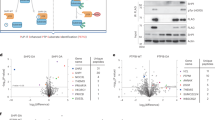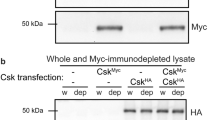Abstract
Src-like adaptor protein 2 (SLAP-2) is a recently characterized adaptor protein bearing sequence and structural similarity to the Src-like adaptor protein (SLAP). SLAP-2 expression is hematopoietic-specific, and it has been demonstrated to function as a negative regulator of T-cell antigen receptor (TCR)-mediated signalling by virtue of its interaction with c-Cbl. Here we report the cloning of a cDNA encoding the human homologue of SLAP-2, as well as the genomic structure of the human SLAP-2 gene. Similar to its murine counterpart, two human SLAP-2 protein isoforms exist because of alternative translation initiation, and SLAP-2 protein expression is observed in a variety of hematopoietic cell lines of both lymphoid and myeloid lineages. The human SLAP-2 gene is located on chromosome 20q, and the SLAP-2 coding region consists of seven exons. Concurrent with the cloning of the full-length SLAP-2 cDNA, a unique cDNA encoding an alternatively spliced SLAP-2 isoform has been identified, and designated as SLAP-2-v. The SLAP-2-v transcript encodes a putative protein of 210 amino acids that lacks the c-Cbl interaction region, and consequently is impaired in its ability to both bind to c-Cbl, and inhibit TCR signalling relative to SLAP-2.
This is a preview of subscription content, access via your institution
Access options
Subscribe to this journal
Receive 50 print issues and online access
$259.00 per year
only $5.18 per issue
Buy this article
- Purchase on Springer Link
- Instant access to full article PDF
Prices may be subject to local taxes which are calculated during checkout





Similar content being viewed by others
References
Berry DM, Benn SJ, Cheng AM and McGlade CJ. (2001). Oncogene, 20, 1203–1211.
Clements JL, Boerth NJ, Lee JR and Koretzky GA. (1999). Annu. Rev. Immunol., 17, 89–108.
Holland SJ, Liao XC, Mendenhall MK, Zhou X, Pardo J, Chu P, Spencer C, Fu A, Sheng N, Yu P, Pali E, Nagin A, Shen M, Yu S, Chan E, Wu X, Li C, Woisetschlager M, Aversa G, Kolbinger F, Bennett MK, Molineaux S, Luo Y, Payan DG, Mancebo HS and Wu J. (2001). J. Exp. Med., 194, 1263–1276.
Joazeiro CA, Wing SS, Huang H, Leverson JD, Hunter T and Liu YC. (1999). Science, 286, 309–312.
Kratchmarova I, Sosinowski T, Weiss A, Witter K, Vincenz C and Pandey A. (2001). Gene, 262, 267–273.
Latour S and Veillette A. (2001). Curr. Opin. Immunol., 13, 299–306.
Liu SK, Fang N, Koretzky GA and McGlade CJ. (1999). Curr. Biol., 9, 67–75.
Loreto MP, Berry DM and McGlade CJ. (2002). Mol. Cell. Biol., 22, 4241–4255.
Lupher Jr ML, Rao N, Lill NL, Andoniou CE, Miyake S, Clark EA, Druker B and Band H. (1998). J. Biol. Chem., 273, 35273–35281.
Lupher Jr ML, Songyang Z, Shoelson SE, Cantley LC and Band H. (1997). J. Biol. Chem., 272, 33140–33144.
MacGrogan D, Alvarez S, DeBlasio T, Jhanwar SC and Nimer SD. (2001). Oncogene, 20, 4150–4160.
Mount SM. (1982) Nucl. Acids Res., 10, 459–472.
Murphy MA, Schnall RG, Venter DJ, Barnett L, Bertoncello I, Thien CB, Langdon WY and Bowtell DD. (1998) Mol. Cell. Biol., 18, 4872–4882.
Pandey A, Ibarrola N, Kratchmarova I, Fernandez MM, Constantinescu SN, Ohara O, Sawasdikosol S, Lodish HF and Mann M. (2002). J. Biol. Chem., 277, 19131–19138.
Rao N, Ghosh AK, Ota S, Zhou P, Reddi AL, Hakezi K, Druker BK, Wu J and Band H. (2001). Embo J, 20, 7085–7095.
Rao N, Lupher Jr ML, Ota S, Reedquist KA, Druker BJ and Band H. (2000). J. Immunol., 164, 4616–4626.
Roulston D, Espinosa 3rd R, Stoffel M, Bell GI and Le Beau MM. (1993). Blood, 82, 3424–3429.
Rudd CE. (1999). Cell, 96, 5–8.
Sosinowski T, Killeen N and Weiss A. (2001). Immunity, 15, 457–466.
Sosinowski T, Pandey A, Dixit VM and Weiss A. (2000). J. Exp. Med., 191, 463–474.
Thien CB, Bowtell DD and Langdon WY. (1999). J. Immunol., 162, 7133–7139.
Wang HY, Altman Y, Fang D, Elly C, Dai Y, Shao Y and Liu YC. (2001). J. Biol. Chem., 276, 26004–26011.
Zhang W, Sloan-Lancaster J, Kitchen J, Trible RP and Samelson LE. (1998). Cell, 92, 83–92.
Acknowledgements
We thank Derek Bouman and Kathy Chun for the FISH analysis, and Hamid Band and Morag Park for the Cbl-N GST fusion construct. As well, we thank Donna Berry and Dwayne Barber for comments on the manuscript. Michael P Loreto is a recipient of a scholarship from the Natural Science and Engineering Research Council of Canada (NSERC). C Jane McGlade is a research scientist of the National Cancer Institute of Canada (NCIC). This work was supported by grants from the Canadian Institutes of Health Research (CIHR) and the Leukemia Research Fund of Canada (LRF).
Author information
Authors and Affiliations
Corresponding author
Rights and permissions
About this article
Cite this article
Loreto, M., McGlade, C. Cloning and characterization of human Src-like adaptor protein 2 and a novel splice isoform, SLAP-2-v. Oncogene 22, 266–273 (2003). https://doi.org/10.1038/sj.onc.1206114
Received:
Revised:
Accepted:
Published:
Issue Date:
DOI: https://doi.org/10.1038/sj.onc.1206114
Keywords
This article is cited by
-
Role of SRC-like adaptor protein (SLAP) in immune and malignant cell signaling
Cellular and Molecular Life Sciences (2015)
-
Slap-2
AfCS-Nature Molecule Pages (2011)



